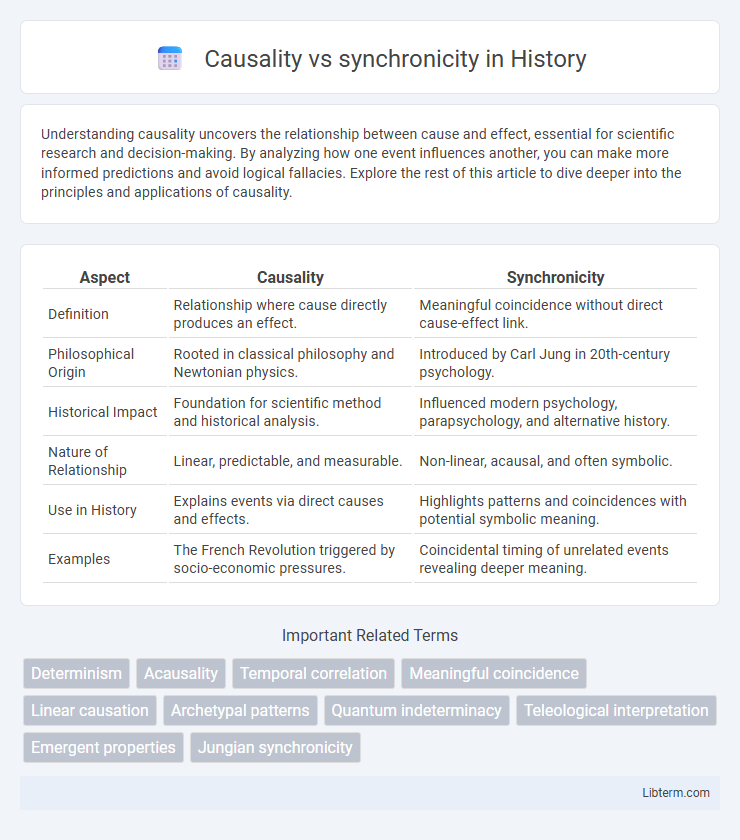Understanding causality uncovers the relationship between cause and effect, essential for scientific research and decision-making. By analyzing how one event influences another, you can make more informed predictions and avoid logical fallacies. Explore the rest of this article to dive deeper into the principles and applications of causality.
Table of Comparison
| Aspect | Causality | Synchronicity |
|---|---|---|
| Definition | Relationship where cause directly produces an effect. | Meaningful coincidence without direct cause-effect link. |
| Philosophical Origin | Rooted in classical philosophy and Newtonian physics. | Introduced by Carl Jung in 20th-century psychology. |
| Historical Impact | Foundation for scientific method and historical analysis. | Influenced modern psychology, parapsychology, and alternative history. |
| Nature of Relationship | Linear, predictable, and measurable. | Non-linear, acausal, and often symbolic. |
| Use in History | Explains events via direct causes and effects. | Highlights patterns and coincidences with potential symbolic meaning. |
| Examples | The French Revolution triggered by socio-economic pressures. | Coincidental timing of unrelated events revealing deeper meaning. |
Defining Causality: The Principle of Cause and Effect
Causality refers to the fundamental principle of cause and effect, where every event or outcome is triggered by a specific preceding cause. This scientific concept establishes a linear relationship between factors, enabling prediction and explanation of phenomena through identifiable agents or actions. Understanding causality is essential for analyzing chains of events and distinguishing genuine influences from mere coincidences.
Understanding Synchronicity: Meaningful Coincidences
Synchronicity refers to meaningful coincidences that occur with no apparent causal relationship yet hold significant personal or collective meaning. Unlike causality, which relies on a direct cause-and-effect connection, synchronicity emphasizes the alignment of events that reveal hidden patterns or messages. This concept, popularized by Carl Jung, suggests an underlying interconnectedness in reality beyond mere chance.
Historical Perspectives on Causality and Synchronicity
Historical perspectives on causality emphasize a linear cause-and-effect relationship rooted in classical physics and Aristotelian logic, where every event is triggered by a preceding cause. Synchronicity, introduced by Carl Jung in the 20th century, challenges this traditional view by positing meaningful coincidences that occur without causal connection but with significant psychological relevance. This concept intersects with philosophical and cultural ideas about interconnectedness, contrasting with deterministic causality in historical debates on the nature of events and human experience.
Key Philosophers and Scientists in the Debate
Philosophers like David Hume critically analyzed causality, emphasizing empirical observation and skepticism about necessary connections between events. Carl Jung introduced the concept of synchronicity, proposing meaningful coincidences not linked by causality but by acausal connections in the psyche. Quantum physicists such as Niels Bohr and Wolfgang Pauli also explored synchronicity, suggesting that classical causality might be insufficient to explain phenomena at the quantum level.
Causality in Science and Everyday Life
Causality in science establishes a clear, testable link between cause and effect, essential for developing reliable theories and conducting experiments. In everyday life, understanding causality helps individuals make informed decisions by predicting outcomes based on past events and observed relationships. Scientific methods such as controlled experiments and statistical analysis reinforce causality, distinguishing it from mere correlation or coincidence.
Synchronicity in Psychology and Spirituality
Synchronicity in psychology and spirituality refers to meaningful coincidences that lack a causal relationship yet hold significant personal significance. Carl Jung introduced this concept to explain events connected by meaning rather than direct cause and effect, emphasizing the role of the collective unconscious and archetypes. In spiritual practices, synchronicity is often viewed as a guiding force or message from the universe, highlighting deep interconnectedness beyond physical causality.
Comparing Mechanistic and Non-Mechanistic Worldviews
The mechanistic worldview interprets causality through linear cause-and-effect relationships, emphasizing predictable, deterministic interactions governed by physical laws. In contrast, the non-mechanistic worldview embraces synchronicity, viewing events as meaningfully connected without direct causal links, often highlighting patterns and holistic interconnections beyond traditional temporal or spatial constraints. This comparison underscores a fundamental epistemological divide: mechanistic models prioritize objective measurement and reductionism, whereas non-mechanistic approaches emphasize subjective experience and interconnectedness within complex systems.
Practical Examples: Causal Chains vs. Synchronous Events
Causal chains involve a sequence where one event directly causes another, such as a lightning strike igniting a forest fire, which then leads to evacuation orders. Synchronous events occur simultaneously without direct causation, like two friends unexpectedly meeting at the same coffee shop despite no prior planning. Understanding this distinction helps in fields like meteorology, where weather patterns can causally influence each other, versus stock market movements that might synchronize due to external economic factors without direct cause-effect relationships.
Implications for Decision-Making and Interpretation
Causality emphasizes linear cause-and-effect relationships, providing clear frameworks for predicting outcomes and making data-driven decisions. Synchronicity highlights meaningful coincidences without direct causation, encouraging intuition and openness to unexpected connections in interpretation. Integrating both approaches enhances decision-making by balancing empirical evidence with recognition of complex patterns beyond traditional logic.
Bridging the Gap: Integrating Causality and Synchronicity
Bridging the gap between causality and synchronicity involves recognizing how cause-and-effect relationships coexist with meaningful coincidences outside linear explanations. Integrating these concepts enhances our understanding of complex phenomena by combining empirical data patterns with symbolic, non-causal connections. This synthesis fosters innovative approaches in fields like psychology, quantum physics, and spirituality, where both deterministic mechanisms and acausal events influence outcomes.
Causality Infographic

 libterm.com
libterm.com